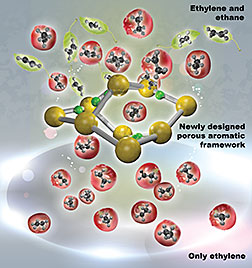- Number 420 |
- August 18, 2014
Cherry picking molecules based on their pi electrons

To eliminate the extreme cooling and
high pressures used to separate ethylene
and ethane, an international team of
scientists, including researchers at
DOE’s
Pacific Northwest National Laboratory,
designed a sorbent that greatly prefers
ethylene.
Specialized windshield glass, everyday plastic water bottles, and countless other products are based on ethylene, a simple two-carbon molecule, which requires an energy-intense separation process to pluck the desired chemical away from nearly identical ethane. To eliminate the extreme cooling required in the separation, an international team including researchers at DOE’s Pacific Northwest National Laboratory designed a material with a porous framework that greatly prefers ethylene. What makes this material particularly potent is that the highly selective sorbent is stable in air and water. In addition, the framework offers a high surface area that speeds the sorting. The material contains silver that binds with the electrons around ethylene's double-bonded carbon atoms. These electrons are known as π electrons or the π cloud.
Every year, billions of tons of ethylene are produced by steam cracking and thermally decomposing ethane. Because ethylene and ethane are roughly the same size and become gases at nearly the same temperature, separating the molecules is extremely difficult on a large scale. This study describes a promising material that does not require extreme pressures or temperatures and far surpasses current zeolites and any other modified framework reported in the scientific literature.
“Compared to existing materials, this is the best material,” said Dr. Praveen Thallapally, a materials scientist at PNNL.
The approach. The researchers created the silver-based porous aromatic framework (PAF) by adding π-complexation or the ability to form a bond between an aromatic ring in the framework with the π electrons in the ethylene. They characterized the material using infrared spectroscopy and other instruments at different facilities. After analyzing the data, the team found that the PAF-1-SO3Ag is exceptionally selective and has a high surface area. Additional experiments, supported by engineering simulations at the University of Amsterdam, indicate that PAF-1-SO3Ag could produce batches of 99.95%+ pure ethylene.
The material holds promise, although there are challenges in both the manufacturing process and the material’s performance. The material paves the way to develop silver-based PAFs that perform complex separations based on pi electrons.
What’s next? The team is taking on one of the material’s challenges: its density. A single gram of the material occupies more space than is practical for larger scale uses. Researchers from the team are working to reduce the material's volume while maintaining its separation capacity.
Sponsors: National Science Foundation (Baiyan Li, Yiming Zhang, Tony Pham, Brian Space, Matthew Chrzanowski, and Shengqian Ma); Scientific User Facility Division, DOE Office of Science, Office of Basic Energy Sciences (Zili Wu); National Natural Science Foundation of China (Dingxuan Ma and Zhan Shi); DOE Office of Basic Energy Sciences Materials Sciences and Engineering Division (Praveen Thallapally and Jun Liu).[Kristin Manke, 509.372.6011,
kristin.manke@pnnl.gov]
